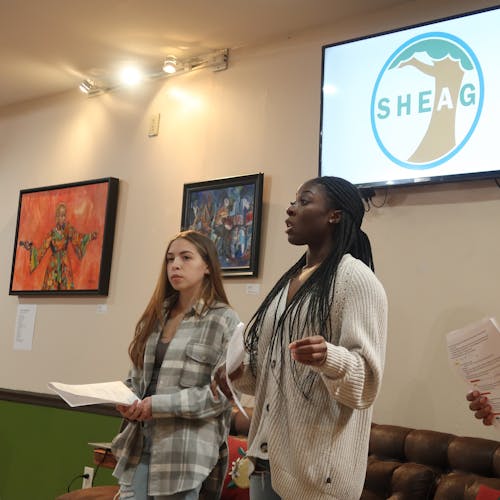Rutgers decorates hundreds of shirts with messages of support for domestic violence victims

Over 500 brightly colored, uniquely-designed shirts streamed across Voorhees Mall on the College Avenue campus for the Rutgers University Office for Violence Prevention and Victim Assistance's (VPVA) annual Clothesline Project.
The event took place Thursday from 9 a.m. to 5 p.m.
“Over 100 new shirts have been created today,” said Loren Linscott, the director of the VPVA.
Linscott said his office believes about 1,000 students viewed the exhibit over the course of the day.
The t-shirts, which have been created by Rutgers students during the Clothesline event over the past 20 years, are meant to bear witness to acts of interpersonal violence experienced by members of the community.
The shirts were created by survivors and other caring individuals to symbolize those who have suffered from domestic violence, sexual assault, physical assault or death, according to a flyer distributed at the event.
“The line here at Rutgers started in the late 90s (by VPVA),” said Laura Luciano, the assistant director for VPVA. “And since then, we’ve been giving survivors and their loved ones the opportunity to create shirts.”
Walking through the exhibit, one saw scrawled onto the shirts tributes to mothers, sisters, cousins and friends, expressions of support, declarations of self-love, and of anger toward perpetrators.
Some were written by current boyfriends, others by brothers, classmates and strangers.
“If you look, some of the messages are about forgiveness, some are about self-worth, some are angry, so it's really kind of where that person is in that moment,” Luciano said. “It’s a way for them to really express themselves, and to just get their message out there.”
Students who made shirts chose from eight colors of fabric — each color signified a different type of violence, explained Luciano, who has been active with this program for more than 20 years.
Although following the color-coding system was not mandatory, according to the flyer shared at the event, a white shirt signified individuals who were murdered by acts of interpersonal violence, yellow represented domestic or dating violence, red or orange stood for sexual assault or rape victims, blue or green was for incestuous abuse or child sexual abuse, purple was for individuals attacked because of their actual or perceived sexual identity or orientation and black stood for those affected by gang rape.
According to the event flyer, the national Clothesline Project began in 1990 with members of the Cape Cod Women’s Agenda, when they hung 31 shirts on a clothesline across the Village Green in Hyannis, Massachusetts. The shirts were designed by survivors of assault, rape and incest. Still growing today, the project now includes 300 Clothesline Projects nationally and internationally, the flyer states, with an estimated 35,000 shirts.
“The group of women (who started the program) had a concept that was similar to the AIDS Quilt,” Luciano said.
The clothesline is a symbolic way to "air the dirty laundry," she said. The message is particularly strong because so many survivors hold onto their experiences as if it is their fault, or they did something wrong, or they are somehow dirty from the experience.
“What we try to really remind people is that the person who did this to you, it’s their secret, their dirtiness, not yours,” she said.
This year, Linscott worked with the office to pioneer an online forum in addition to the physical exhibit, he said. The forum, which can be accessed through the VPVA website, opened on Sept. 14 and will accept submissions Sept. 18 through 5 p.m. The submissions will be displayed on the VPVA website.
The goal of the Virtual Clothesline Project was to provide an outlet for students who are not comfortable making a physical shirt, Linscott said.
“There’s no one timeline for trauma healing,” Linscott said.
He stressed that other goals of this project are to make students aware of resources available on campus through the VPVA office, and also to facilitate a meaningful conversation between students.
“This event is so powerful that I think it does inspire people to connect,” he said. “We know that people who talk about their experience — and create a plan to develop healthy coping skills and mechanisms — certainly do better academically, socially and may be generally happier. They may suffer less from depression. There really is a link.”
In a culture that tends to normalize interpersonal violence, this project seeks to raise awareness about the issues and to cultivate empathy in students, who are statistically more likely to be approached by a survivor for help than to be a victim themselves, Linscott said.
He said the goal is to make bystander intervention the norm.
“A lot of students don’t know that this impacts students in our community,” Luciano said. “They think, ‘Oh, these are things that are happening globally or downtown, but not happening to our students,’ so we really want to remind people that these are things that are happening here, and they’re not alone, and there are resources.”



